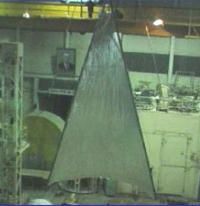Cosmos-1 Spacecraft Design
The first solar-sail spacecraft, called Cosmos-1, has been developed, built and tested by The Planetary Society, a private, non-profit organization whose goal is to encourage the exploration of our solar system. The Planetary Society contracted a Russian space organization, the Babakin Space Center, to build, launch and operate the spacecraft. The cost of the project is about $4-million and is funded by Cosmos Studios, a new science-based media company.
Cosmos-1 spacecraft
The spacecraft itself weighs 88 lb (40 kg) and can sit on a tabletop. After a first-phase test launch, the spacecraft will be launched into Earth orbit -- 522 mi (840 km) perigee and 528 mi (850 km) apogee. The spacecraft systems include:
Advertisement
Solar sail
- made of aluminized Mylar
- thickness of 0.0002 inches (5 microns)
- area of 6,415 square feet (600 square meters)
- arranged in eight triangular blades, each about 49 ft (15 m) long and consisting of inflatable plastic tubes that support the sail (a foam may be used inside the tubes to hold them rigid once inflated). Each blade can be pivoted (like a helicopter blade) by electric motors to change its angle relative to the sun.
Solar-sail deployment - A pressurized gas-filling system inflates the plastic tubes.
Solar-sail deployment
Power - A small array of solar cells supplies all of the electrical power.
- Navigation - It is essential for the spacecraft to know where it is and where the sun is at all times.
- A sensor detects the position of the sun.
- A global positioning system (GPS) receiver detects the spacecraft's position. (From the ground, the spacecraft orbit will be determined from Doppler tracking data with the aid of on-board accelerometers, which we'll discuss later.)
- The information from the sun sensor and the GPS receiver are continuously relayed to the spacecraft's on-board computer.
- The on-board computer operate the motors that turn the sail blades to maintain the proper orientation of the sail blades with respect to the sun.
- The on-board computer can accept corrections or override commands from the ground.
Communications - Redundant radio systems are used to communicate with flight controllers on the ground.
- one UHF band, 400 megahertz
- one S-band, 2210 MHz
On-board computer
- Two 386EX series microprocessors: old, but reliable in the harsh environment of outer space; can be run in low-power modes, similar to laptop computers; programmed to operate the on-board systems, relay information to the ground and receive commands from the ground
- A software program assigns tasks to each microprocessor based on workload and performance (speed, delay).
- Each processor has its own small amount of read-only memory (ROM) -- enough to boot the computer and load the operating system into random-access memory (RAM).
- Three re-writable ROMs contain the operating systems and programs. The copies of ROM are checked before use for errors caused by radiation in outer space.
- Three RAMs are present to receive the operating system. Again, the integrity of each RAM is checked for errors before loading.
- The ROM architecture allows programmers on the ground to update and re-boot the spacecraft's software at any time. It also allows the spacecraft to function in the case of severe radiation damage.
- Data are stored in two separate databases connected by serial and parallel systems.
Instruments
- Two on-board imaging cameras (Russian and American) to document the mission
- On-board accelerometers to measure the acceleration of the spacecraft due to sunlight pressure (non-gravitational acceleration)
In the next section, we'll discuss the details of the Cosmos-1 mission.
